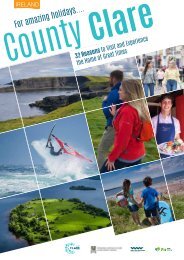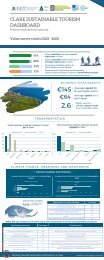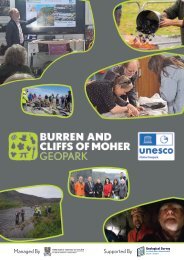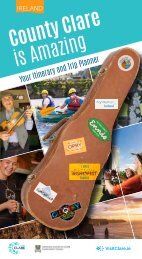Burren and Cliffs of Moher UNESCO Global Geopark - Geology
A collection of articles about the geology in the Burren and Cliffs of Moher UNESCO Global Geopark written by Dr Eamon Doyle - Geopark Geologist
A collection of articles about the geology in the Burren and Cliffs of Moher UNESCO Global Geopark written by Dr Eamon Doyle - Geopark Geologist
You also want an ePaper? Increase the reach of your titles
YUMPU automatically turns print PDFs into web optimized ePapers that Google loves.
Erratic Rocks<br />
A notable feature <strong>of</strong> the exposed rock <strong>of</strong> the<br />
<strong>Burren</strong> are the large boulders that sit on top <strong>of</strong><br />
the limestone. Some <strong>of</strong> the best examples are seen<br />
along the coast road between Ballyrean <strong>and</strong> Black<br />
Head or Rock Forest near Mullaghmore. These are<br />
called ‘glacial erratics’ <strong>and</strong> they were transported to<br />
their present position by large ice sheets that moved<br />
across Irel<strong>and</strong> during the last period <strong>of</strong> glaciation<br />
which was at its maximum about 22,000 years ago.<br />
Boulders such as this are known from across<br />
northern Europe <strong>and</strong> North America <strong>and</strong> during<br />
the 17th Century they were originally thought to be<br />
evidence <strong>of</strong> the Great Flood. It wasn’t until the 19th<br />
Century that the idea that major glaciations in the<br />
past had shaped the Earth’s surface became accepted<br />
thanks to publications by eminent geologists such<br />
as Charles Lyell’s Principles <strong>of</strong> <strong>Geology</strong> in 1830.<br />
The name comes from the Greek word ‘errare’<br />
meaning to w<strong>and</strong>er. The term is applied to rocks<br />
that have been carried some distance from their<br />
original outcrop. We have some excellent examples<br />
<strong>of</strong> large granite boulders that have come from<br />
across Galway Bay. There are no outrops <strong>of</strong> Galway<br />
Granite in the <strong>Burren</strong> so the boulders must have<br />
been transported here. The vast majority <strong>of</strong> our<br />
erratic boulders are limestone <strong>and</strong> local to the<br />
<strong>Burren</strong>, so the transport distances aren’t huge.<br />
One <strong>of</strong> the useful features <strong>of</strong> erratics is that<br />
they can tell us the direction that the ice flowed,<br />
so we know that the Galway granite boulders<br />
were carried south to the <strong>Burren</strong> by ice sheets<br />
flowing from Connemara. In southern County<br />
Clare at the Bridges <strong>of</strong> Ross we have erratics that<br />
were carried there from County Kerry whereas<br />
in eastern Clare we find erratics carried from<br />
the Slieve Aughty mountains. This tells us that<br />
local ice sheet flow spread out from regional<br />
upl<strong>and</strong> areas <strong>and</strong> that while the overall flow<br />
<strong>of</strong> the main ice sheets in Irel<strong>and</strong> was from the<br />
northeast, the local pattern can be more complex.<br />
While currently these boulders st<strong>and</strong> proud <strong>and</strong><br />
exposed it is possible that they were once part<br />
<strong>of</strong> glacial Boulder Clay deposits (a mixture <strong>of</strong><br />
boulders <strong>and</strong> ground up rock clay) which have lost<br />
all the finer material due to erosion. The amount <strong>of</strong><br />
Boulder Clay that has been eroded, the erosional<br />
processes involved or when that erosion happened<br />
has yet to be established. Some boulders are split in<br />
half or thirds, this is most likely due to the action<br />
<strong>of</strong> freeze-thaw processes in the periglacial period<br />
after the rock was deposited when severe seasonal<br />
freezing <strong>and</strong> thawing would have been common.<br />
More recently, these erratics can be used to<br />
establish when the last ice sheets melted. Dr.<br />
Gordon Bromley, a glaciologist from NUI Galway<br />
is currently studying our Buren erratics. By<br />
calculating when these boulders were last exposed<br />
to cosmic radiation, it is possible to estimate when<br />
they were exposed after the last ice sheets melted.<br />
For an alternative <strong>and</strong> thoroughly entertaining<br />
story about how the <strong>Burren</strong> got covered in boulders<br />
I can recommend Eddie Lenihan’s book ‘Irish Tales<br />
<strong>of</strong> Mystery <strong>and</strong> Magic’ published by Mercier Press.<br />
Article written by Dr. Eamon Doyle, Geologist for<br />
<strong>Burren</strong> <strong>and</strong> <strong>Cliffs</strong> <strong>of</strong> <strong>Moher</strong> <strong>UNESCO</strong> <strong>Global</strong> <strong>Geopark</strong>, Clare County Council.<br />
www.burrengeopark.ie


















